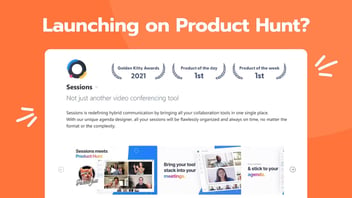
According to a report published by Doodle, a professional spends two hours/per week in unproductive meetings. This means more than 16 billion hours/year wasted for the US only, which translates into a loss of $399 billion.
The hybrid meetings are even more complex than other online meetings. Having a split audience, physically present and online, means you always think and prepare for two scenarios. How will you make everyone feel included? Will everyone collaborate? What tools do you use?
Here are five things to take into consideration when holding a hybrid meeting:
1. Invest in audio quality
Video quality is essential, but equally or more relevant is to be heard. Imagine the discomfort when your online participants constantly ask you to repeat everything said in the meeting room. They lose valuable information, as well as time and energy. And you’ll also avoid frustration from those onliners struggling to understand the conversation and from those offline who have to repeat themselves time and time again.
Ask in-person participants to speak up. Use one or multiple mics if necessary. Adapt the environment for a better acoustic. Invest in good equipment when it comes to audio.
2. Don’t neglect your online participants
It’s easier to form bonds with those physically present in the same space as you, read their body language, and adapt your presentation. They’re close to you. You’ve probably had a small talk with them during the day. It may seem unimportant, but it’s constructive to form ties. It’s also simpler to engage with them.
So make it a point to involve the people joining online actively. Involve them in small talks, ask for their opinions, and contribute to the conversation.
3. Test before the meeting
As we already mentioned, you need more technology and creativity to make hybrid meetings a success.
You’ll probably use new equipment and platforms like Sessions, so make sure to check that everything works properly before the conference. Also, invite your online participants to join you a few minutes earlier to familiarize themselves with the features they might find helpful (Sessions example: My Notes, Questions, Takeaways, Agenda etc.).
4. Designate an assistant
An Assistant could have two roles:
- Your online assistant who navigates the platform in your place. In Sessions, you assign this role to one or more participants.
- A physical counterpart for the online participants. They would function as a contact person if something goes wrong or there are some technical difficulties. They could also represent those online in a physical exercise by writing down on the flip-chart in their place.
The assistant could be the same person with these two roles or find two distinct people. It depends on your needs.
It’s a subtle way to show that your online attendees are as crucial as those in the room. You’ve thought about their needs, and you’re trying to involve them as much as possible.
5. Keep it short
Before anything else, make sure to ask yourself this: is this meeting vital? Is there another way to solve this issue that could be more time-efficient?
Long meetings cost you time, money and your team’s productivity. Should you decide it’s needed, remember that your role as organizer of the conference (a session’s owner) is vital.
Make sure to plan your agenda well to have concise materials and information. Expect your hybrid meetings to require more effort and planning on your part. But it will be worth it.
Let’s wrap it up
Sessions is a video-conferencing tool that can be your ally in hybrid meetings since it is a one-in-all management toolbox. The platform brings together meeting tools and collaborative tools to help you create remarkable online, offline and hybrid conferences. Give it a try, it’s free!





Comment on this post